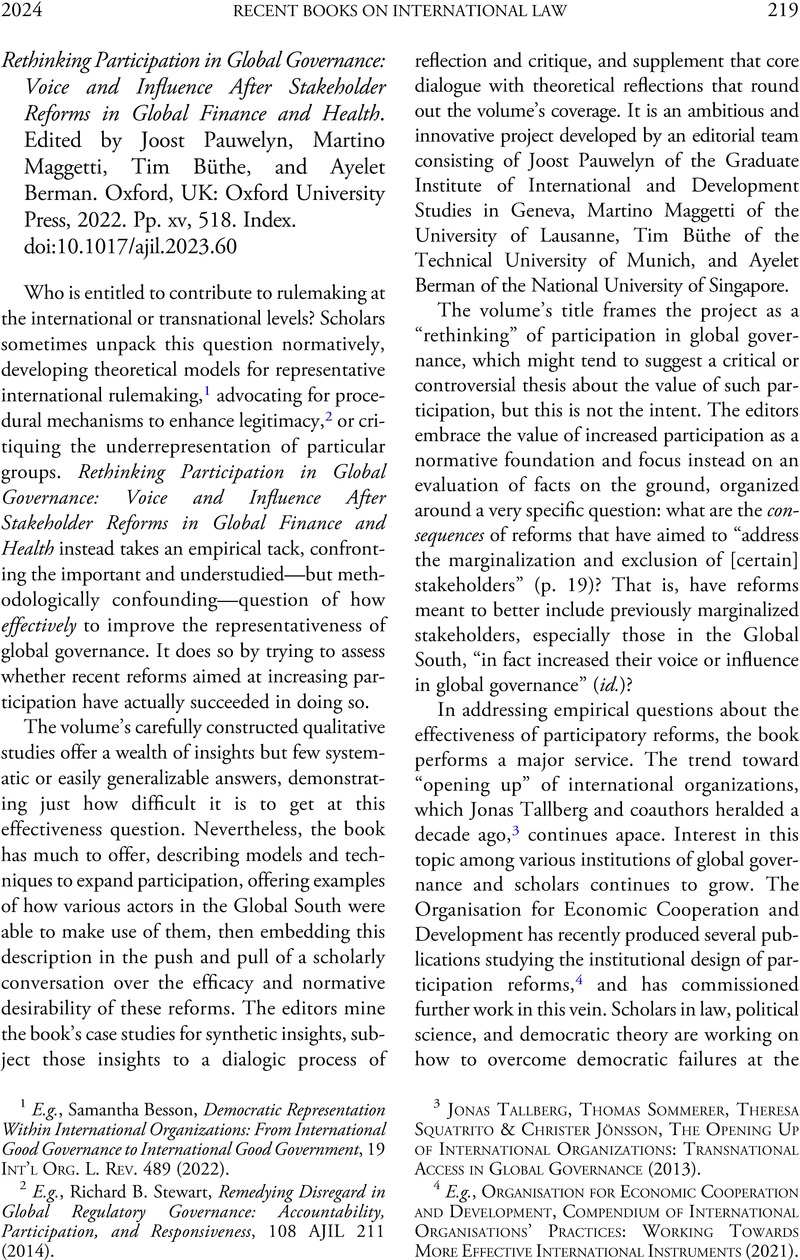No CrossRef data available.
Article contents
Rethinking Participation in Global Governance: Voice and Influence After Stakeholder Reforms in Global Finance and Health. Edited by Joost Pauwelyn, Martino Maggetti, Tim Büthe, and Ayelet Berman. Oxford, UK: Oxford University Press, 2022. Pp. xv, 518. Index.
Review products
Published online by Cambridge University Press: 29 January 2024
Abstract

- Type
- Book Reviews
- Information
- Copyright
- Copyright © The Author(s), 2024. Published by Cambridge University Press on behalf of American Society of International Law
References
1 E.g., Besson, Samantha, Democratic Representation Within International Organizations: From International Good Governance to International Good Government, 19 Int'l Org. L. Rev. 489 (2022)Google Scholar.
2 E.g., Stewart, Richard B., Remedying Disregard in Global Regulatory Governance: Accountability, Participation, and Responsiveness, 108 AJIL 211 (2014)CrossRefGoogle Scholar.
3 Jonas Tallberg, Thomas Sommerer, Theresa Squatrito & Christer Jönsson, The Opening Up of International Organizations: Transnational Access in Global Governance (2013).
4 E.g., Organisation for Economic Cooperation and Development, Compendium of International Organisations’ Practices: Working Towards More Effective International Instruments (2021).
5 See, e.g., Besson, supra note 1.
6 See, e.g., GA Res. 77/244 on “Promotion of Inclusive and Effective Tax Cooperation at the United Nations” (Jan. 9, 2023).
7 Shaffer, Gregory & Ginsburg, Tom, The Empirical Turn in International Legal Scholarship, 106 AJIL 1 (2012)CrossRefGoogle Scholar.
8 See Raustiala, Kal, The “Participatory Revolution” in International Environmental Law, 21 Harv. Envtl. L. Rev. 537 (1997)Google Scholar.
9 UN Secretary-General Press Release, Partnership with Civil Society Necessity in Addressing Global Agenda, Says Secretary-General in Wellington, New Zealand Remarks, UN Press Release SG/SM/7318 (Feb. 29, 2000) (remarks by Secretary-General Kofi Annan), at http://www.un.org/press/en/2000/20000229.sgsm7318.doc.html.
10 See Durkee, Melissa J., International Lobbying Law, 127 Yale L.J. 1742 (2018)Google Scholar (characterizing this view as “strong legitimacy optimism”).
11 von Bernstorff, Jochen, New Responses to the Legitimacy Crisis of International Institutions: The Role of “Civil Society” and the Rise of the Principle of Participation of “The Most Affected” in International Institutional Law, 32 Eur. J. Int. L. 125 (2021)Google Scholar.
12 Durkee, Melissa J., Astroturf Activism, 69 Stan. L. Rev. 201 (2017)Google Scholar; see also Durkee, supra note 10.
13 Georg Kell, Relations with the Private Sector, in The Oxford Handbook of International Organizations (Jacob Katz Cogan, Ian Hurd & Ian Johnstone eds., 2017).


